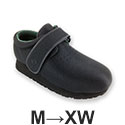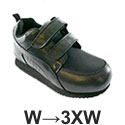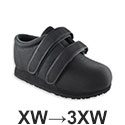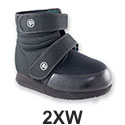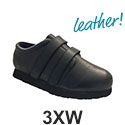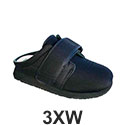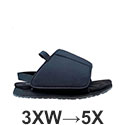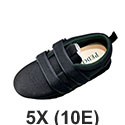Mens Orthopedic Shoes - A Buyers Guide
One way to define the features as to what makes for a good orthopedic shoe for men is to review the difference between orthopedic shoes for men and women.
The goal of both mens and womens orthopedic shoes is to provide comfort, support, and relief for various foot conditions or concerns. In general, the primary differences between orthopedic shoes for men and women lie in the design, sizing, and style preferences.
Here are some key considerations regarding the differences between orthopedic shoes for men and women.
• Design and Style
Last Shape: The last is the mold around which a shoe is constructed. In general, women's shoes tend to have a narrower last, reflecting the typical shape of a woman's foot, while men's shoes have a broader last to accommodate the wider shape of a man's foot.
Heel Height: Womens orthopedic shoes may offer more variations in heel height compared to mens shoes. This reflects the diversity in women's style preferences and the types of shoes they may wear.
• Sizing
Width: Womens orthopedic shoes often come in a wider range of width options, including narrow, regular, wide, and extra-wide. Mens orthopedic shoes also offer width options but may have a different range.
Length: Sizing for both mens and womens shoes follows standard length measurements. However, womens shoes may have more half-size options, reflecting the narrower width variances.
• Colors and Aesthetics
Color Options: Womens orthopedic shoes may offer a broader range of colors and patterns, catering to different style preferences. Men's orthopedic shoes typically have more neutral color options.
Aesthetic Details: The aesthetic details, such as stitching patterns and embellishments, may vary based on gender norms and style preferences.
• Toe Box Shape
Toe Shape: Women's shoes may have a slightly more tapered or pointed toe box compared to the broader toe box often found in men's shoes. The toe box shape can affect comfort, especially for individuals with conditions like bunions or hammertoes.
• Sizes and Conversions
Size Conversions: While both mens and womens orthopedic shoes follow standard sizing, it's important to note that there may be differences in size conversion between men’s and women's sizes. For example, a men's size 8 is not be the same as a women's size 8, and vice versa.
• Style Preferences
Variety in Styles: Women's orthopedic shoes may include a broader variety of styles, including sandals, flats, athletic shoes, and dress shoes, catering to different wardrobe needs. Men's orthopedic shoes also come in various styles but may have a more limited range.
Despite these general differences, it's crucial to recognize that everyone's feet are unique, and individual preferences and needs vary. Some individuals may prefer the style or fit of a shoe designed for the opposite gender. Additionally, many orthopedic shoe brands aim to provide unisex styles or offer similar features in both mens and womens lines. When selecting orthopedic shoes, prioritize comfort, proper fit, and the specific features recommended by a healthcare professional rather than strictly adhering to gender norms.
What Are Orthopedic Shoes? | Pedors

The video was uploaded on 7/28/2021.
You can view the video here.
The video lasts for 31 seconds.

By Stephen O'Hare, President and Co-Founder, Pedors Shoes
For over 25 years Pedors Shoes has designed and manufactured shoes for problem feet. Our goal is to get our customers back on their feet again with affordable, quality footwear that addresses their specific needs. We’re here to help. Your footwear problems are our challenges.
Mens Orthopedic Shoes for Seniors
Choose an orthopedic shoe that is age appropriate.
Orthopedic Shoes are worn by people of all ages for various needs or reasons. As people age and as physical strength diminishes with age, it’s easy to imagine how a senior might prefer something more lightweight to make it easier and less burdensome to wear than heavier shoes.
What shoes do orthopedic doctors recommend?
The medical prognosis dictates the design features required.
Your doctor is going to recommend an orthopedic shoe that can accommodate your specific medical need. For example, a Vascular Surgeon treating a patient with venous insufficiency and swollen feet is going to recommned a different type of orthopedic shoe than a Podiatrist treating a patient who is trying to cope with a bunion or a hammertoe. Similarly a Rheumatologist treating a patient with arthritis will look for different features than an Endocrinologist helping a patient to manage their diabetes.
Orthopedic Walking Shoes for Men
What are the features to look for in orthopedic walking shoes?
Finding good orthopedic shoes for walking can be the first step to significantly improved physical and mental health, independence and overall quality of life.
• Arch Support
Orthopedic walking shoes typically feature built-in arch support to help maintain the natural arch of the foot. Adequate arch support is crucial for individuals with conditions such as flat feet or overpronation.
• Cushioning
Extra cushioning in the insole and midsole provides shock absorption, reducing the impact on the feet and joints during walking. This feature is essential for individuals with arthritis, plantar fasciitis, or other conditions causing foot pain.
• Wide Toe Box
A wide and roomy toe box allows toes to spread naturally and minimizes pressure on the front of the foot. This is beneficial for individuals with bunions, hammertoes, or other toe deformities.
• Removable Insoles
Many orthopedic walking shoes come with removable insoles, allowing individuals to use custom orthotic inserts prescribed by their healthcare provider for personalized support.
• Adjustable Closures
Adjustable closures, such as Velcro straps or laces, enable a secure and customizable fit. These closures are particularly useful for individuals with foot swelling or those who have difficulty with traditional fastenings.
• Firm Heel Counter
A firm heel counter provides stability to the heel and helps control excessive motion, promoting proper foot alignment. This feature is essential for individuals with overpronation or supination.
• Lightweight Construction
Orthopedic walking shoes are often designed to be lightweight, making them more comfortable for extended periods of walking. Lighter shoes can reduce fatigue and help improve gait and stability.
Some good orthopedic walking shoes brands for men include Clarks Hoka and Saucony
Mens Orthopedic Dress Shoes
We like to recommend the San Antonio Shoes Company for mens orthopedic dress shoes.
Mens Orthopedic Golf Shoes
Pedors does not make an Orthopedic Golf Shoe but we often get asked to recommend one. I highly recommend Sqairz which offers superior support, stability and an oblique toe box which also helps you line up your putts!!
Mens Orthopedic Pickelball Shoes
We would be remiss if we didn’t share a recommendation for America’s fastest growing sport. I think the best option for a mens pickleball shoethat is available in wide widths is K Swiss
Mens Orthopedic Shoes For Swollen Feet, Diabetes, Arthritis, Edema and More
If you have any of the above foot concerns it may well be that Pedors Shoes are the perfect fit for you. Our shoes feature seamless stretch uppers with adjustable closures, removable insoles and are available in six widths.
USA Free Shipping & Free Return Shipping = No Risk
We offer free shipping and free return shipping so that you can try the shoes on in the comfort of your home and if they don't work out, send them back for a full no questions asked refund.
>>To View All The Mens Orthopedic Shoes Pedors Offers Follow This Link To The Orthopedic Shoes For Men Section<<
Conclusion on Pedors Shoes Guide to Mens Orthopedic Shoes
Before purchasing orthopedic shoes, it's advisable to consult with a healthcare professional, such as a podiatrist or orthopedic specialist, to ensure that the chosen footwear is appropriate for your specific foot condition. They can provide guidance on the features you need and may even be able to recommend specific brands or models. Additionally, consider getting professionally measured to ensure the proper fit, as well-fitting shoes are crucial for foot health.
Well that about wraps it up for this page on orthopedic shoes for men. You will hopefully now be in a better position to understand how to go about getting the right shoes for your foot condition by knowing:
- What features those shoes need to have
- What to look out for when buying shoes online or elsewhere
- How to size your feet and determine your width
If you have any questions please don't hesitate to email us at support@pedors.com or call 1-800-750-6729 if in the USA or +1 770 218 8282 if outside the USA.



